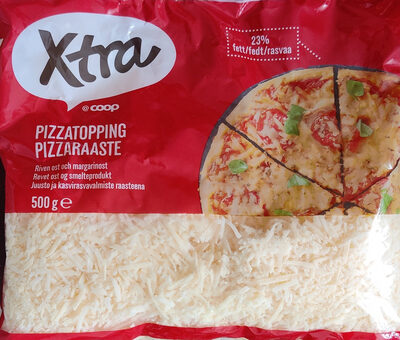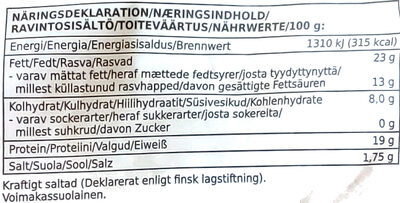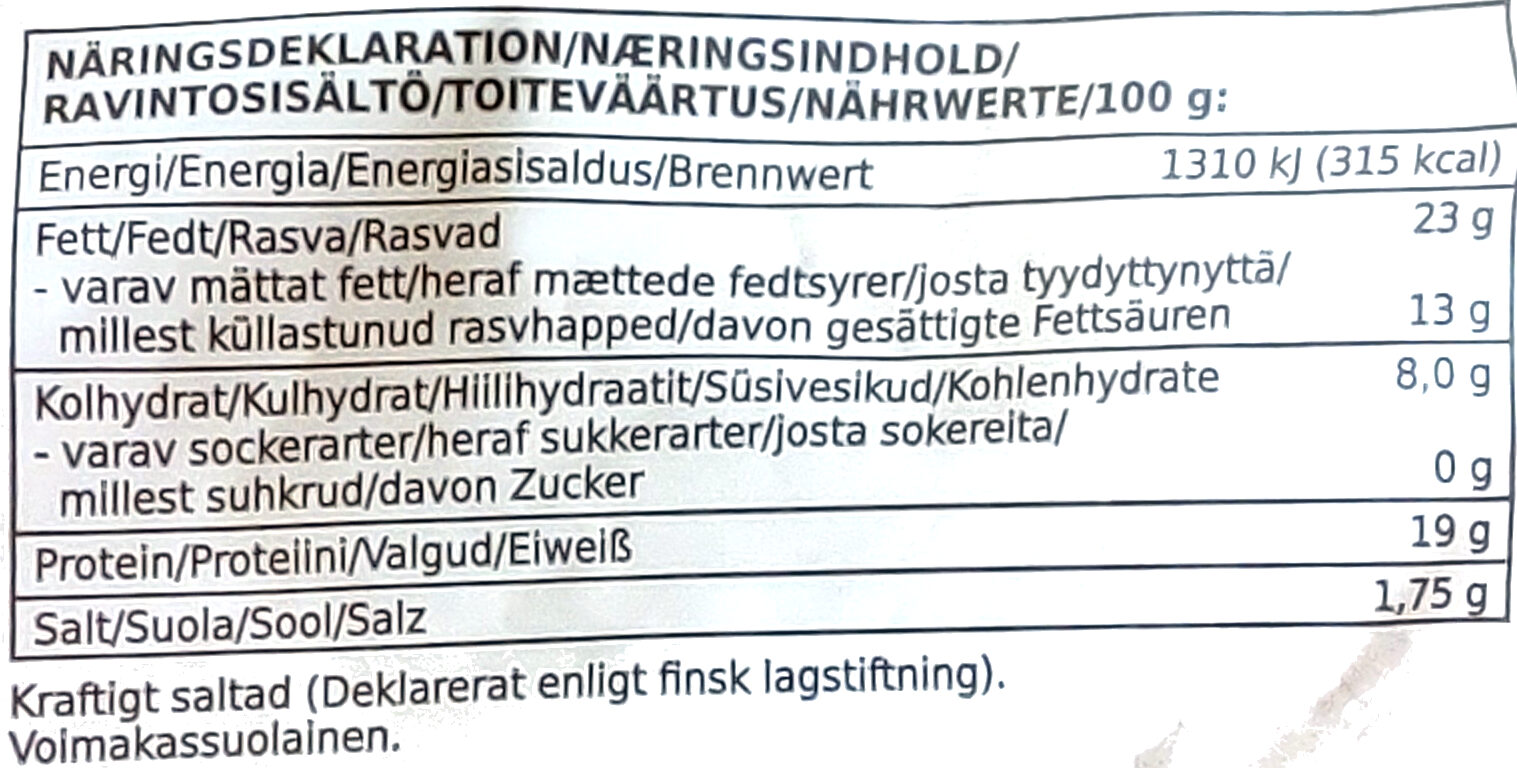Help us make food transparency the norm!
As a non-profit organization, we depend on your donations to continue informing consumers around the world about what they eat.
The food revolution starts with you!
Pizzatopping - Coop - 500 g
Pizzatopping - Coop - 500 g
Streckkod: 7340011300755 (EAN / EAN-13)
Vanligt namn: Riven ost (49%) och margarinost, 23% fett.
Kvantitet: 500 g
Förpackning: Plast
Varumärken: Coop, X-Tra, Vepo Cheese
Kategorier: Mejeriprodukt, Fermenterad mat, Fermenterade mjölkprodukter, Ostar, en:Grated cheese
Origin of the product and/or its ingredients: Mjölkens ursprung: Se märkning vid Bäst Före-datumet. Om två lånder anges är mjölken en blandning med följande ur-sprung: DE—Tyskland, Nederländerna, BE—Belgien, IE=Irland. GB=Storbritannien, DK=Danmark, FR=Frankrike.
Ingredients ursprung: Storbritannien, Frankrike, Tyskland, en:Great Britain, Österrike, Belgien, Danmark, Irland, Nederländerna
Spårbarhetskod: NL Z-0244 EG
Butiker: Coop
Länder där såld: Sverige
Matching with your preferences
Hälsa
Ingredienser
-
25 ingredienser
Ost 49% (mjölk, salt, mjölksyrakultur, löpe. konserveringsmedel (E 251), färgämne (E 160a)), smältprodukt 49% (vatten, potatisstärkelse, palmolja, salt, bambufiber, skummjölkspulver, smältsalt (E 339, E 330), konserveringsmedel (E 202), färgämne (E 160a), arom), potatisstärkelse.Allergener: Mjölk
Food processing
-
Ultra processed foods
Elements that indicate the product is in the 4 - Ultra bearbetade livsmedel och drycker group:
- Tillsats: E160a - Karoten
- Ingrediens: Färg
- Ingrediens: Arom
Food products are classified into 4 groups according to their degree of processing:
- Obearbetade eller minimalt bearbetade livsmedel
- Bearbetade kulinariska ingredienser
- Halvfabrikat
- Ultra processed foods
The determination of the group is based on the category of the product and on the ingredients it contains.
Tillsatser
-
E160a - Karoten
Carotene: The term carotene -also carotin, from the Latin carota, "carrot"- is used for many related unsaturated hydrocarbon substances having the formula C40Hx, which are synthesized by plants but in general cannot be made by animals -with the exception of some aphids and spider mites which acquired the synthesizing genes from fungi-. Carotenes are photosynthetic pigments important for photosynthesis. Carotenes contain no oxygen atoms. They absorb ultraviolet, violet, and blue light and scatter orange or red light, and -in low concentrations- yellow light. Carotenes are responsible for the orange colour of the carrot, for which this class of chemicals is named, and for the colours of many other fruits, vegetables and fungi -for example, sweet potatoes, chanterelle and orange cantaloupe melon-. Carotenes are also responsible for the orange -but not all of the yellow- colours in dry foliage. They also -in lower concentrations- impart the yellow coloration to milk-fat and butter. Omnivorous animal species which are relatively poor converters of coloured dietary carotenoids to colourless retinoids have yellowed-coloured body fat, as a result of the carotenoid retention from the vegetable portion of their diet. The typical yellow-coloured fat of humans and chickens is a result of fat storage of carotenes from their diets. Carotenes contribute to photosynthesis by transmitting the light energy they absorb to chlorophyll. They also protect plant tissues by helping to absorb the energy from singlet oxygen, an excited form of the oxygen molecule O2 which is formed during photosynthesis. β-Carotene is composed of two retinyl groups, and is broken down in the mucosa of the human small intestine by β-carotene 15‚15'-monooxygenase to retinal, a form of vitamin A. β-Carotene can be stored in the liver and body fat and converted to retinal as needed, thus making it a form of vitamin A for humans and some other mammals. The carotenes α-carotene and γ-carotene, due to their single retinyl group -β-ionone ring-, also have some vitamin A activity -though less than β-carotene-, as does the xanthophyll carotenoid β-cryptoxanthin. All other carotenoids, including lycopene, have no beta-ring and thus no vitamin A activity -although they may have antioxidant activity and thus biological activity in other ways-. Animal species differ greatly in their ability to convert retinyl -beta-ionone- containing carotenoids to retinals. Carnivores in general are poor converters of dietary ionone-containing carotenoids. Pure carnivores such as ferrets lack β-carotene 15‚15'-monooxygenase and cannot convert any carotenoids to retinals at all -resulting in carotenes not being a form of vitamin A for this species-; while cats can convert a trace of β-carotene to retinol, although the amount is totally insufficient for meeting their daily retinol needs.Källa: Wikipedia (Engelska)
-
E202 - Kaliumsorbat
Potassium sorbate: Potassium sorbate is the potassium salt of sorbic acid, chemical formula CH3CH=CH−CH=CH−CO2K. It is a white salt that is very soluble in water -58.2% at 20 °C-. It is primarily used as a food preservative -E number 202-. Potassium sorbate is effective in a variety of applications including food, wine, and personal-care products. While sorbic acid is naturally occurring in some berries, virtually all of the world's production of sorbic acid, from which potassium sorbate is derived, is manufactured synthetically.Källa: Wikipedia (Engelska)
-
E251 - Natriumnitrat
Sodium nitrate: Sodium nitrate is the chemical compound with the formula NaNO3. This alkali metal nitrate salt is also known as Chile saltpeter -because large deposits of this salt can be found in Chile- to distinguish it from ordinary saltpeter, potassium nitrate. The mineral form is also known as nitratine, nitratite or soda niter. Sodium nitrate is a white solid very soluble in water. It is a readily available source of the nitrate anion -NO3−-, which is useful in several reactions carried out on industrial scales for the production of fertilizers, pyrotechnics and smoke bombs, glass and pottery enamels, food preservatives -esp. meats-, and solid rocket propellant. It has been mined extensively for these purposes.Källa: Wikipedia (Engelska)
-
E330 - Citronsyra
Citric acid: Citric acid is a weak organic acid that has the chemical formula C6H8O7. It occurs naturally in citrus fruits. In biochemistry, it is an intermediate in the citric acid cycle, which occurs in the metabolism of all aerobic organisms. More than a million tons of citric acid are manufactured every year. It is used widely as an acidifier, as a flavoring and chelating agent.A citrate is a derivative of citric acid; that is, the salts, esters, and the polyatomic anion found in solution. An example of the former, a salt is trisodium citrate; an ester is triethyl citrate. When part of a salt, the formula of the citrate ion is written as C6H5O3−7 or C3H5O-COO-3−3.Källa: Wikipedia (Engelska)
-
E339 - Natriumfosfater
Sodium phosphates: Sodium phosphate is a generic term for a variety of salts of sodium -Na+- and phosphate -PO43−-. Phosphate also forms families or condensed anions including di-, tri-, tetra-, and polyphosphates. Most of these salts are known in both anhydrous -water-free- and hydrated forms. The hydrates are more common than the anhydrous forms.Källa: Wikipedia (Engelska)
Ingrediensanalys
-
Palmolja
Ingredienser som innehåller palmolja: Palmolja
-
Icke-vegan
Non-vegan ingredients: Ost, Mjölk, SkummjölkspulverVissa ingredienser kunde inte kännas igen.
Vi behöver din hjälp!
You can help us recognize more ingredients and better analyze the list of ingredients for this product and others:
- Edit this product page to correct spelling mistakes in the ingredients list, and/or to remove ingredients in other languages and sentences that are not related to the ingredients.
- Add new entries, synonyms or translations to our multilingual lists of ingredients, ingredient processing methods, and labels.
If you would like to help, join the #ingredients channel on our Slack discussion space and/or learn about ingredients analysis on our wiki. Thank you!
-
Vegetarisk status okänd
Okända ingredienser: SmältproduktVissa ingredienser kunde inte kännas igen.
Vi behöver din hjälp!
You can help us recognize more ingredients and better analyze the list of ingredients for this product and others:
- Edit this product page to correct spelling mistakes in the ingredients list, and/or to remove ingredients in other languages and sentences that are not related to the ingredients.
- Add new entries, synonyms or translations to our multilingual lists of ingredients, ingredient processing methods, and labels.
If you would like to help, join the #ingredients channel on our Slack discussion space and/or learn about ingredients analysis on our wiki. Thank you!
-
Details of the analysis of the ingredients
Vi behöver din hjälp!
Vissa ingredienser kunde inte kännas igen.
Vi behöver din hjälp!
You can help us recognize more ingredients and better analyze the list of ingredients for this product and others:
- Edit this product page to correct spelling mistakes in the ingredients list, and/or to remove ingredients in other languages and sentences that are not related to the ingredients.
- Add new entries, synonyms or translations to our multilingual lists of ingredients, ingredient processing methods, and labels.
If you would like to help, join the #ingredients channel on our Slack discussion space and/or learn about ingredients analysis on our wiki. Thank you!
: Ost 49% (mjölk, salt, mjölksyrakultur, löpe, konserveringsmedel (e251), färgämne (e160a)), smältprodukt 49% (vatten, potatisstärkelse, palmolja, salt, bambufiber, skummjölkspulver, smältsalt (e339, e330), konserveringsmedel (e202), färgämne (e160a), arom), potatisstärkelse- Ost -> en:cheese - vegan: no - vegetarian: maybe - ciqual_proxy_food_code: 12999 - percent_min: 49 - percent: 49 - percent_max: 49
- mjölk -> en:milk - vegan: no - vegetarian: yes - ciqual_proxy_food_code: 19051 - percent_min: 40.25 - percent_max: 49
- salt -> en:salt - vegan: yes - vegetarian: yes - ciqual_food_code: 11058 - percent_min: 0 - percent_max: 1.75
- mjölksyrakultur -> en:lactic-ferments - vegan: maybe - vegetarian: yes - percent_min: 0 - percent_max: 1.75
- löpe -> en:rennet - vegan: maybe - vegetarian: maybe - percent_min: 0 - percent_max: 1.75
- konserveringsmedel -> en:preservative - percent_min: 0 - percent_max: 1.75
- e251 -> en:e251 - vegan: yes - vegetarian: yes - percent_min: 0 - percent_max: 1.75
- färgämne -> en:colour - percent_min: 0 - percent_max: 1.75
- e160a -> en:e160a - vegan: maybe - vegetarian: maybe - from_palm_oil: maybe - percent_min: 0 - percent_max: 1.75
- smältprodukt -> sv:smältprodukt - percent_min: 49 - percent: 49 - percent_max: 49
- vatten -> en:water - vegan: yes - vegetarian: yes - ciqual_food_code: 18066 - percent_min: 4.9 - percent_max: 49
- potatisstärkelse -> en:potato-starch - vegan: yes - vegetarian: yes - ciqual_proxy_food_code: 9510 - percent_min: 0 - percent_max: 24.5
- palmolja -> en:palm-oil - vegan: yes - vegetarian: yes - from_palm_oil: yes - ciqual_food_code: 16129 - percent_min: 0 - percent_max: 16.3333333333333
- salt -> en:salt - vegan: yes - vegetarian: yes - ciqual_food_code: 11058 - percent_min: 0 - percent_max: 1.75
- bambufiber -> en:bamboo-fibre - vegan: yes - vegetarian: yes - percent_min: 0 - percent_max: 1.75
- skummjölkspulver -> en:skimmed-milk-powder - vegan: no - vegetarian: yes - ciqual_food_code: 19054 - percent_min: 0 - percent_max: 1.75
- smältsalt -> en:emulsifying-salts - percent_min: 0 - percent_max: 1.75
- e339 -> en:e339 - vegan: yes - vegetarian: yes - percent_min: 0 - percent_max: 1.75
- e330 -> en:e330 - vegan: yes - vegetarian: yes - percent_min: 0 - percent_max: 0.875
- konserveringsmedel -> en:preservative - percent_min: 0 - percent_max: 1.75
- e202 -> en:e202 - vegan: yes - vegetarian: yes - percent_min: 0 - percent_max: 1.75
- färgämne -> en:colour - percent_min: 0 - percent_max: 1.75
- e160a -> en:e160a - vegan: maybe - vegetarian: maybe - from_palm_oil: maybe - percent_min: 0 - percent_max: 1.75
- arom -> en:flavouring - vegan: maybe - vegetarian: maybe - percent_min: 0 - percent_max: 1.75
- potatisstärkelse -> en:potato-starch - vegan: yes - vegetarian: yes - ciqual_proxy_food_code: 9510 - percent_min: 2 - percent_max: 2
Näring
-
Poor nutritional quality
⚠ ️Warning: the amount of fruits, vegetables and nuts is not specified on the label, it was estimated from the list of ingredients: 0This product is not considered a beverage for the calculation of the Nutri-Score.
Positiva poäng: 5
- Proteiner: 5 / 5 (värde: 19, avrundat värde: 19)
- Fiber: 0 / 5 (värde: 0, avrundat värde: 0)
- Frukt, grönsaker, nötter och raps- / valnöt- / olivoljor: 0 / 5 (värde: 0, avrundat värde: 0)
Negativa poäng: 20
- Energi: 3 / 10 (värde: 1310, avrundat värde: 1310)
- Socker: 0 / 10 (värde: 0, avrundat värde: 0)
- Mättat fett: 10 / 10 (värde: 13, avrundat värde: 13)
- Natrium: 7 / 10 (värde: 700, avrundat värde: 700)
The points for proteins are counted because the product is in the cheeses category.
Näringsvärde: (20 - 5)
Nutri-Score:
-
Näringsvärden
-
Fett i hög kvantitet (23%)
What you need to know- A high consumption of fat, especially saturated fats, can raise cholesterol, which increases the risk of heart diseases.
Recommendation: Limit the consumption of fat and saturated fat- Choose products with lower fat and saturated fat content.
-
Mättat fett i hög kvantitet (13%)
What you need to know- A high consumption of fat, especially saturated fats, can raise cholesterol, which increases the risk of heart diseases.
Recommendation: Limit the consumption of fat and saturated fat- Choose products with lower fat and saturated fat content.
-
Sockerarter i låg kvantitet (0%)
What you need to know- A high consumption of sugar can cause weight gain and tooth decay. It also augments the risk of type 2 diabetes and cardio-vascular diseases.
Recommendation: Limit the consumption of sugar and sugary drinks- Sugary drinks (such as sodas, fruit beverages, and fruit juices and nectars) should be limited as much as possible (no more than 1 glass a day).
- Choose products with lower sugar content and reduce the consumption of products with added sugars.
-
Salt i hög kvantitet (1.75%)
What you need to know- A high consumption of salt (or sodium) can cause raised blood pressure, which can increase the risk of heart disease and stroke.
- Many people who have high blood pressure do not know it, as there are often no symptoms.
- Most people consume too much salt (on average 9 to 12 grams per day), around twice the recommended maximum level of intake.
Recommendation: Limit the consumption of salt and salted food- Reduce the quantity of salt used when cooking, and don't salt again at the table.
- Limit the consumption of salty snacks and choose products with lower salt content.
-
-
Näringsfakta
Näringsfakta Som såld
för 100 g / 100 mlCompared to: en:Grated cheese Energi 1 310 kj
(315 kcal)−10 % Fett 23 g −14 % Mättat fett 13 g −26 % Kolhydrat 8 g +349 % Sockerarter 0 g −100 % Fiber - Protein 19 g −26 % Salt 1,75 g +11 % Fruits‚ vegetables‚ nuts and rapeseed‚ walnut and olive oils (estimate from ingredients list analysis) 0 %
Miljö
-
Eco-Score C - Måttlig miljöpåverkan
The Eco-Score is an experimental score that summarizes the environmental impacts of food products.→ The Eco-Score was initially developped for France and it is being extended to other European countries. The Eco-Score formula is subject to change as it is regularly improved to make it more precise and better suited to each country.Life cycle analysis
-
Average impact of products of the same category: C (Score: 54/100)
Kategori: Camembert cheese, from cow's milk
Kategori: Camembert cheese, from cow's milk
- PEF environmental score: 0.50 (the lower the score, the lower the impact)
- including impact on climate change: 5.24 kg CO2 eq/kg of product
Stage Impact Jordbruk
84.4 %Bearbetar
5.6 %Förpackning
4.4 %Transportation
3.3 %Distribution
1.8 %Consumption
0.5 %
Bonuses and maluses
-
Origins of ingredients with a medium impact
Bonus: +9
Environmental policy: +4
Transportation: +5
Origin of the product and/or its ingredients % of ingredients Impact Österrike 12 %Medium Belgien 12 %Medium Danmark 12 %Låg Frankrike 12 %Medium Tyskland 12 %Medium Irland 12 %Medium Nederländerna 12 %Medium Storbritannien 12 %Medium
-
Ingredients that threatens species
Malus: -10
Contains palm oil
Tropical forests in Asia, Africa and Latin America are destroyed to create and expand oil palm tree plantations. The deforestation contributes to climate change, and it endangers species such as the orangutan, the pigmy elephant and the Sumatran rhino.
-
Packaging with a medium impact
Malus: -10
Form Material Återvinning Impact Okänd Okänd Hög ⚠ ️ The information about the packaging of this product is not sufficiently precise (exact shapes and materials of all components of the packaging).⚠ ️ For a more precise calculation of the Eco-Score, you can modify the product page and add them.
If you are the manufacturer of this product, you can send us the information with our free platform for producers.
Eco-Score for this product
-
Impact for this product: C (Score: 43/100)
Produkt: Pizzatopping - Coop - 500 g
Life cycle analysis score: 54
Sum of bonuses and maluses: -11
Final score: 43/100
-
Carbon footprint
-
Equal to driving 2.7 km in a petrol car
524 g CO² per 100g of product
The carbon emission figure comes from ADEME's Agribalyse database, for the category: Camembert cheese, from cow's milk (Source: ADEME Agribalyse Database)
Stage Impact Jordbruk
85.1 %Bearbetar
5.0 %Förpackning
5.0 %Transportation
4.0 %Distribution
0.7 %Consumption
0.1 %
Förpackning
-
Packaging with a medium impact
-
Packaging parts
Okänd
-
Packaging materials
Material % Packaging weight Packaging weight per 100 g of product
-
Transportation
-
Origins of ingredients
Origins of ingredients with a medium impact
Origin of the product and/or its ingredients % of ingredients Impact Österrike 12 %Medium Belgien 12 %Medium Danmark 12 %Låg Frankrike 12 %Medium Tyskland 12 %Medium Irland 12 %Medium Nederländerna 12 %Medium Storbritannien 12 %Medium
Hotade arter
-
Contains palm oil
Drives deforestation and threatens species such as the orangutan
Tropical forests in Asia, Africa and Latin America are destroyed to create and expand oil palm tree plantations. The deforestation contributes to climate change, and it endangers species such as the orangutan, the pigmy elephant and the Sumatran rhino.
Report a problem
-
Incomplete or incorrect information?
Category, labels, ingredients, allergens, nutritional information, photos etc.
If the information does not match the information on the packaging, please complete or correct it. Open Food Facts is a collaborative database, and every contribution is useful for all.
Datakällor
Produkt tillagd den av akitainu
Senast ändrad produktsida på av odinh.
Produktsida också redigerad av ecoscore-impact-estimator, openfoodfacts-contributors.












